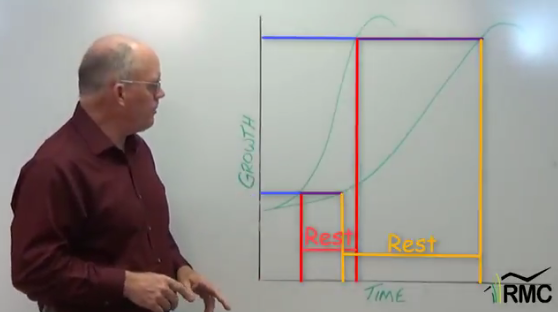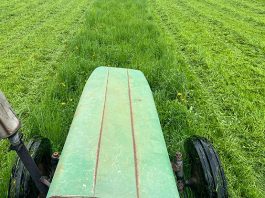“The tree grows in a Bermuda pasture and is always loaded in the fall with luscious fruit. The cows and hogs stand under it, always ready to devour every pod that falls. The tree is very large and very, very beautiful. The cows improve in milk and the hogs in weight when the locusts ripen, for there are always bushels and bushels on the tree.”
-Ellen Williams of Georgia, quoted in J. Russell Smith’s Tree Crops (1929)
If you’ve read my previous article on honey locust, you know it is a game-changing source of winter stockpiled feed. Throughout most of the United States, there is no better tree to add feed to a farm during those critical winter months.
Now, let’s take a closer look at the value of honey locust pods, and just how much feed they can add to your stockpile.
Before we get started though, let’s be clear: your results will vary. Whether you’re on rocky soils in New York or a well-drained valley bottom in Georgia or a windy knob in Kansas will play a big factor in the yields you get. Sorry, but if you’re on a hill in Vermont, you’ll never get the pod yield a grazier on Mississippi bottomland can expect. So adjust your expectations accordingly.
Let’s start by establishing the forage yield on this model farm.
I’ll use the hay yield data from 2019 in Virginia (a state where honey locust grows well and has been well studied). The data shows average hay yields of 2.2 ton/acre. Let’s assume good management and round that number up to 2.5 tons/acre, or 5,000lbs/acre as fed. Assuming 18% moisture in the hay, that turns into 4,100 lbs. of dry matter.

Now on to the honey locust pods. For the sake of this calculation, we’ll use 100lbs/tree/year as a nice round number. I have commonly seen trees, both wild and from selected stock, produce well over 300lbs in a given year. However, honey locust have a masting tendency, where they’ll yield heavy one year and lightly the next. So, years need evened out. Thankfully, trees don’t sync up their masting tendency like oaks do (where all the oaks in the forest yield heavy or light the same years). Therefore, a diverse selection of honey locusts will balance each other out. Here is a paper reporting the yield from a grove of grafted honey locust at Auburn University (way back in 1947). The average yield for the grafted Millwood variety at ages 9-10 was 43.5kg, or 95.7 lbs. Being grafted trees, that yield will be on the high end for young trees, but they are very young trees. Unfortunately, we don’t have data on how those trees yielded at ages 20 or 50 or 80. So we’ll use the round number of 100 lbs/tree/year. Depending on your conditions, the care you give the trees, genetics and the maturity of the trees, you could get much less or much more than this number.
Next, how many trees will this acre have? There is no perfect number of trees to establish, since there are always tradeoffs. Plant 200 trees/acre and you’ll quickly get to ideal shade levels and good pod production. However, the cost of establishing 200 high-quality trees on an acre is probably too high for consideration, given the fact you’ll need to start thinning them within ten years or so. On the other side of the spectrum, just 10 trees per acre will cost less to establish, but will take a generation to reach more ideal shade conditions, and two or three generations before the pod yields equal that of a more densely planted acre. For this calculation, we’ll go somewhere in the middle with a spacing of 30’x40’, giving us 36 trees/acre

Together, the 36 trees/acre and 100 pounds of pods/tree get us to a yield of 3,600 lbs/acre. That’s quite the yield boost when it’s an addition to the 5,000 pounds/acre of forages. Will forage growth be reduced? Potentially, though that’ll depend on many factors, like your forage type, aspect of your pasture, climate, etc. Cool-season forages will love the dappled shade of the honey locust and do better in summer than if they were baking in the hot July sun. Honey locust tends to leaf out later than many species, so it allows more sunlight to reach forages in early spring. A likely outcome of adding nice dappled shade trees to pastures at low densities (we’re not talking a forest here) is a slight reduction of forage mass in the spring and fall, but stronger growth into the hot months when growth would otherwise slump. And a good fodder tree will more than make up for any yield decline by dropping pods.
We would be missing out on some key insight if we only looked at the pounds yielded by forages and pods. Saying those two feeds are the same would be like equating a glass of skim milk to a glass of whole milk. The big difference is that a pound of honey locust pods is much more energy dense than a pound of hay. So for the sake of a more nuanced comparison, let’s look at the caloric energy each feed breaks down to.
Let’s start with the hay. At roughly 950 calories/pound of hay DM, we’re looking at the pasture producing 3,895,000 calories in forages/acre/year.
Now, let’s look at what kind of caloric yield comes from those 3,600 lbs of pods. The pods (containing 29% sugar) analyzed for Feedipedia contained 18.3 MJ/KG on a DM basis. Translate that to calories/pound for pods, and you get 1,981 calories/pound. Let’s assume that the 100 lbs of honey locust pods dropped from our 36 trees contained 35% moisture, so that each tree yielded 65 lbs of actual dry matter. That yields 128,765 calories/tree, or 4,635,540 calories/acre.
Go back and read that again if you wish (and here’s a table to show the calculations clearly).

This represents a huge increase in feed, all without adding another square foot of land. It more than doubles the feed yielded per acre, plus shade and all the weight gain benefits that come from that, plus a more diverse and resilient ecosystem, plus a great PR campaign!
Now this is a simplistic model as we’ve already stated. In reality I don’t want people to go create honey locust monocultures. There are a ton of other trees with good practical value in a pasture. Persimmons will drop feed like honey locusts do (dropping fruit from August through January or later depending on variety). If you can grow honey locust, you can grow persimmon. Oaks are another that graziers have used, and burr oaks will bear acorns almost the size of a golf ball. Then you have all kinds of trees that may not drop a mast crop, but will provide other services, like nitrogen fixation (black locusts, alder, mimosa), windbreak (evergreens and any densely planted deciduous trees), leaf fodder as a supplement (mulberry, hybrid poplar, willow). If you’re reading this, I can be confident you recognize the value of a polyculture. But there’s nothing that beats a good honey locust for silvopasture.

This is a snapshot of honey locust in its infancy. There has been almost zero breeding work done on this tree, a tree that already can outyield what corn produced until the Green Revolution (average per acre corn yields in the US was around 30 bushels/acre, or a mere 2.6 million calories/acre, until 1935). Why hasn’t more work been done? A lack of patience and long-term vision. Several breeding efforts were started along the way, but most were abandoned when leadership changed or newer, shinier, better-funded opportunities (like corn and soybean research) appeared. Today, however, is a different day. The spell and allure of industrial monocropping is starting to break down, and there’s a growing push to perennialize agriculture and store carbon in the soil where it belongs. You are part of that wave, creating the conditions for healthier food, deeper soil, and stable communities. In our societal push to plow hedgerow to hedgerow, we neglected the grasses and trees that form the basis of good stewardship. They should be neglected no longer.





Honeylocust are awesome trees. We’ve planted some, left wild ones along and will plant more along with persimmons.
Great info. AMAZING feed yields. Thanks. I am curious about creating a living fence/hedge row with honey locust. Any thoughts to share on this ponder?
Hi Annie,
They should do fantastic in that role. I’d direct-seed them a few inches apart. You could go to Sheffield Seed and buy the seed you need. Might as well get the standard thorny stuff if you want a really strong fence. Or you can get the thornless seed (look for the word ‘inermis’, which means thornless). Even so you’ll get a certain percentage with thorns, just to be aware.
Are you talking about thornless honey locust trees?
Milwood mentioned is thornless. I have thornless Hersey and Calhoune. The ones you want have high yields and no or few thorns. There are thornless ornamental types widely cultivated but they have a low pod yield. I’ve got several wild ones I let grow around the pasture as well because of their high yield. I know they’re a tractor risk but I either transplant, dig up or graft to any seedlings I find.
I fully agree with Anthony’s comment. One thing to note is that grafted trees are thornless, because the graft material is taken from upper, mature parts of the tree. Since the tree only produces thorns on the lower, younger parts of the tree (a defense mechanism against large herbivores), the upper sections genetically no longer produce thorns. It’s a nice little biology trick.
So when you grow trees from seed, some number will have thorns on them. I’ve yet to find a source that’s 100% thornless. But you can graft on to a thorny tree, and it will become completely thorness. If you graft on a high-yielding variety (Calhoun, Hershey, Millwood, etc) you’ll get high yields of good pods as well.
How well do honey locust trees handle deer scrapes?
Mine have survived the brush hog. They usually come back. Deer scrapes could cause them to send out new shoots from the roots. I’ve never seen a deer scrape on most. I have had issues with deer eating the leaves from short trees. They LOVE the leaves. I keep them in a 5′ tree tube until they’re taller.
These trees are tough as nails. I’ve seen one seedling survive being in the middle of a portable pig pen for a week, with the pigs rolling all over it. Even still I usually start all my trees in a 6′ tree shelter if protecting against cattle, 5′ if only deer or sheep. That’ll give them the good boost to get started, and protect them from herbivores.
Comments are closed.